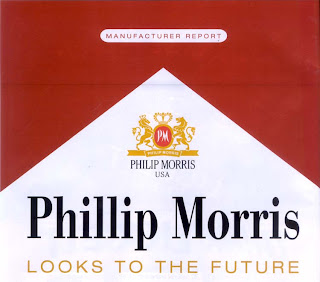British American Tobacco Plc (BATS) said Australia’s planned cigarette plain-packaging law is unconstitutional and if enacted, the company will sue in the nation’s top court in a bid to repeal it.
The Australian Senate is scheduled to vote on the legislation today after debating it. The government will push back implementation of the law by five months to December 2012 because of delays in parliament’s upper house in passing the bill, Australian Health Minister Nicola Roxon said Nov. 2.
Passage would make the country the first to ban logos on cigarette packaging. Cigarettes would have to be sold in plain dark-olive packages, with no company logos and the same font for all brands.
“It is unconstitutional for the federal government to remove a legal company’s valuable property without compensation,” London-based BAT’s Australian unit said in an e- mailed statement today referring to the company’s trademarks. The cigarette maker said it “confirmed it will commence proceedings in the High Court against the federal government” should the legislation pass the Senate.
The Australian government announced the plan to ban branding on cigarette packs in April last year, along with a 25 percent increase in tobacco taxes and an A$85 million ($86 million) advertising campaign to combat smoking.
Roxon Responds
Smoking kills 15,000 Australians each year and costs the nation about A$31 billion annually in health and workplace expenses, according to the government. With 15.1 percent of the population aged 14 or over smoking daily, it is the country’s top drug and preventable health issue, the government said.
“We won’t be bullied by tobacco companies threatening litigation and we are prepared to fight them if they do,” Roxon said in Melbourne today.
Cigarette makers including BAT and Philip Morris International Inc., the world’s largest publicly traded tobacco company, have taken legal action against the Australian move.
Philip Morris said in June that it served the Australian government with a notice of claim stating its intention to pursue its case in international arbitration. The Australian proposal violates a treaty with Hong Kong and may cause billions of dollars in damages, the maker of Marlboro cigarettes said.
“Criminal Gangs”
“No other country in the world has implemented plain packaging and there are many good reasons for that,” BAT Australia said in today’s statement. “It will make criminal gangs countless dollars as they reproduce plain-packaged cigarettes with ease.”
Cigarette packs in Australia already contain graphic warnings including pictures of diseased lungs that cover half the back of a package.
In the U.S., a federal judge on Nov. 7 blocked rules from taking effect that would order tobacco companies to display graphic health warnings, saying the move may violate their rights to free speech.
The Australian Senate is scheduled to vote on the legislation today after debating it. The government will push back implementation of the law by five months to December 2012 because of delays in parliament’s upper house in passing the bill, Australian Health Minister Nicola Roxon said Nov. 2.
Passage would make the country the first to ban logos on cigarette packaging. Cigarettes would have to be sold in plain dark-olive packages, with no company logos and the same font for all brands.
“It is unconstitutional for the federal government to remove a legal company’s valuable property without compensation,” London-based BAT’s Australian unit said in an e- mailed statement today referring to the company’s trademarks. The cigarette maker said it “confirmed it will commence proceedings in the High Court against the federal government” should the legislation pass the Senate.
The Australian government announced the plan to ban branding on cigarette packs in April last year, along with a 25 percent increase in tobacco taxes and an A$85 million ($86 million) advertising campaign to combat smoking.
Roxon Responds
Smoking kills 15,000 Australians each year and costs the nation about A$31 billion annually in health and workplace expenses, according to the government. With 15.1 percent of the population aged 14 or over smoking daily, it is the country’s top drug and preventable health issue, the government said.
“We won’t be bullied by tobacco companies threatening litigation and we are prepared to fight them if they do,” Roxon said in Melbourne today.
Cigarette makers including BAT and Philip Morris International Inc., the world’s largest publicly traded tobacco company, have taken legal action against the Australian move.
Philip Morris said in June that it served the Australian government with a notice of claim stating its intention to pursue its case in international arbitration. The Australian proposal violates a treaty with Hong Kong and may cause billions of dollars in damages, the maker of Marlboro cigarettes said.
“Criminal Gangs”
“No other country in the world has implemented plain packaging and there are many good reasons for that,” BAT Australia said in today’s statement. “It will make criminal gangs countless dollars as they reproduce plain-packaged cigarettes with ease.”
Cigarette packs in Australia already contain graphic warnings including pictures of diseased lungs that cover half the back of a package.
In the U.S., a federal judge on Nov. 7 blocked rules from taking effect that would order tobacco companies to display graphic health warnings, saying the move may violate their rights to free speech.
 RSS Feed
RSS Feed Twitter
Twitter 1:04 AM
1:04 AM
 Alexis
Alexis






 mostly medium-brown ribbons, and nothing foreign was found in the mix. About 1/8 inch of
mostly medium-brown ribbons, and nothing foreign was found in the mix. About 1/8 inch of  separated by what appears to be charcoal granules. We could definitely determine that the last part of the filter is made of something different than the ordinary cellulose found in filters. It can be described as a paper folded many, many times. In our tamp-down test, the tobacco compressed about 1/8 inch. The tobacco is made of mostly brown ribbons, and there was nothing out of the ordinary in it. We were very impressed with this one; it had a good rich flavor, didn’t burn too quickly, and the draw was nice and easy. This is a new breed of smoke in that it is made with genetically altered tobacco (like Omni) with increasingly lower nicotine levels. Although it says “low nicotine” right on the box, and these smokes have a new-fangled filter that may reduce carcinogens, the manufacturer makes no claims that Quest is safer than any other, and it is not being marketed as a smoking-cessation product, either. Nevertheless, we liked this one, and if perhaps it is one day proven to be “safer”, so much the better.
separated by what appears to be charcoal granules. We could definitely determine that the last part of the filter is made of something different than the ordinary cellulose found in filters. It can be described as a paper folded many, many times. In our tamp-down test, the tobacco compressed about 1/8 inch. The tobacco is made of mostly brown ribbons, and there was nothing out of the ordinary in it. We were very impressed with this one; it had a good rich flavor, didn’t burn too quickly, and the draw was nice and easy. This is a new breed of smoke in that it is made with genetically altered tobacco (like Omni) with increasingly lower nicotine levels. Although it says “low nicotine” right on the box, and these smokes have a new-fangled filter that may reduce carcinogens, the manufacturer makes no claims that Quest is safer than any other, and it is not being marketed as a smoking-cessation product, either. Nevertheless, we liked this one, and if perhaps it is one day proven to be “safer”, so much the better.

 Pall Mall Lights Menthol 100′s Box – Made by Brown & Williamson Tobacco Corp., Louisville, Kentucky. Length: 3 7/8 inches, 98mm; filter 13/16 inch, 20 mm. The tobacco, comprised mostly of medium-brown ribbons, contained nothing unusual in the sample we checked out. In the tamp-down test, it compressed about 1/8 inch. The Old Guy was pretty pleased with this one. He liked the way it went down (not rough at all, even though he was sick), and he was impressed with the smooth, but pretty powerful, flavor. Though touted as a menthol, very little of that came through to the Old Guy, which is always a bonus for him. Also, he found no unpleasant aftertaste whatsoever in this one. The major drawback: it burns way too slowly. The Old Guy commented that, in the 100 style, and if a person were so inclined, you could get two smokes out of one with these. And it even states right on the foil wrap inside the box, “Burns Slower”. In spite of that, he gave it about a 7.5 on a scale to 10. Another bonus: because this is not classed as a “premium”, you can get it for a pretty decent price. Bottom line: give these a go, if you are ready to try a good, solid generic brand.
Pall Mall Lights Menthol 100′s Box – Made by Brown & Williamson Tobacco Corp., Louisville, Kentucky. Length: 3 7/8 inches, 98mm; filter 13/16 inch, 20 mm. The tobacco, comprised mostly of medium-brown ribbons, contained nothing unusual in the sample we checked out. In the tamp-down test, it compressed about 1/8 inch. The Old Guy was pretty pleased with this one. He liked the way it went down (not rough at all, even though he was sick), and he was impressed with the smooth, but pretty powerful, flavor. Though touted as a menthol, very little of that came through to the Old Guy, which is always a bonus for him. Also, he found no unpleasant aftertaste whatsoever in this one. The major drawback: it burns way too slowly. The Old Guy commented that, in the 100 style, and if a person were so inclined, you could get two smokes out of one with these. And it even states right on the foil wrap inside the box, “Burns Slower”. In spite of that, he gave it about a 7.5 on a scale to 10. Another bonus: because this is not classed as a “premium”, you can get it for a pretty decent price. Bottom line: give these a go, if you are ready to try a good, solid generic brand. Made in Columbia and imported by Freedom, “a little tobacco company”. Length:1/8 inches, 80 mm; filter 9/16 inch, 15 mm. The tobacco is a standard blend of medium-brown flakes and ribbons, and three pieces of stem were found in the sample that was inspected. In the tamp-down test, it compressed about 1/8 inch. One notable thing: the filter is recessed ј inch. The Old Guy didn’t care for this brand at all. He said it was possibly the weakest full-flavor he had ever tasted. The draw was extremely hard, which he thought could be attributed to the “funny” filter. He thought it went down okay, and it burned at an average rate. However, these didn’t make up for the wicked aftertaste it left him with.
Made in Columbia and imported by Freedom, “a little tobacco company”. Length:1/8 inches, 80 mm; filter 9/16 inch, 15 mm. The tobacco is a standard blend of medium-brown flakes and ribbons, and three pieces of stem were found in the sample that was inspected. In the tamp-down test, it compressed about 1/8 inch. One notable thing: the filter is recessed ј inch. The Old Guy didn’t care for this brand at all. He said it was possibly the weakest full-flavor he had ever tasted. The draw was extremely hard, which he thought could be attributed to the “funny” filter. He thought it went down okay, and it burned at an average rate. However, these didn’t make up for the wicked aftertaste it left him with.


 Cigs Menthol Light King…Made in Canada. Length: 3 ј inches, 83 mm; filter ѕ inch, 20mm. The tobacco is a standard blend of medium-brown ribbons and flakes, and one fairly large piece of woody stem was found in the sample. Negligible results were obtained in the tamp-down test. The Old Guy really liked this one. He thought it had a nice, easy drag and that it went down smoothly. The burn rate was just what it should be, also. He was particularly impressed with the taste, which he said had just the right amount of menthol flavor. The Old Guy thought this one was very similar to a Basic Menthol Light. He said a person really can’t miss with this one…
Cigs Menthol Light King…Made in Canada. Length: 3 ј inches, 83 mm; filter ѕ inch, 20mm. The tobacco is a standard blend of medium-brown ribbons and flakes, and one fairly large piece of woody stem was found in the sample. Negligible results were obtained in the tamp-down test. The Old Guy really liked this one. He thought it had a nice, easy drag and that it went down smoothly. The burn rate was just what it should be, also. He was particularly impressed with the taste, which he said had just the right amount of menthol flavor. The Old Guy thought this one was very similar to a Basic Menthol Light. He said a person really can’t miss with this one…

 Vegas Full Flavor King – Made by Star Tobacco, Petersburg, Pennsylvania. Length 3 ј inches, 83 mm; filter 1 inch, 25 mm. The tobacco is a course-cut standard blend with a strong binder. One piece of stem was found in the mix. In the tamp-down test, about 1/16 inch of tobacco compressed. Also, unlike other Star Tobacco products, this one didn’t have a charcoal-embedded filter. The Old Guy was very pleased with this one. He said it had everything a good full flavor smoke should have: an easy drag, smooth draw, and a rich, bold flavor (that means STRONG to the rest of us). He even liked the name of this brand. Also, he liked the burn rate. Would he smoke more packs of these (or maybe even buy them)? You bet…
Vegas Full Flavor King – Made by Star Tobacco, Petersburg, Pennsylvania. Length 3 ј inches, 83 mm; filter 1 inch, 25 mm. The tobacco is a course-cut standard blend with a strong binder. One piece of stem was found in the mix. In the tamp-down test, about 1/16 inch of tobacco compressed. Also, unlike other Star Tobacco products, this one didn’t have a charcoal-embedded filter. The Old Guy was very pleased with this one. He said it had everything a good full flavor smoke should have: an easy drag, smooth draw, and a rich, bold flavor (that means STRONG to the rest of us). He even liked the name of this brand. Also, he liked the burn rate. Would he smoke more packs of these (or maybe even buy them)? You bet…









